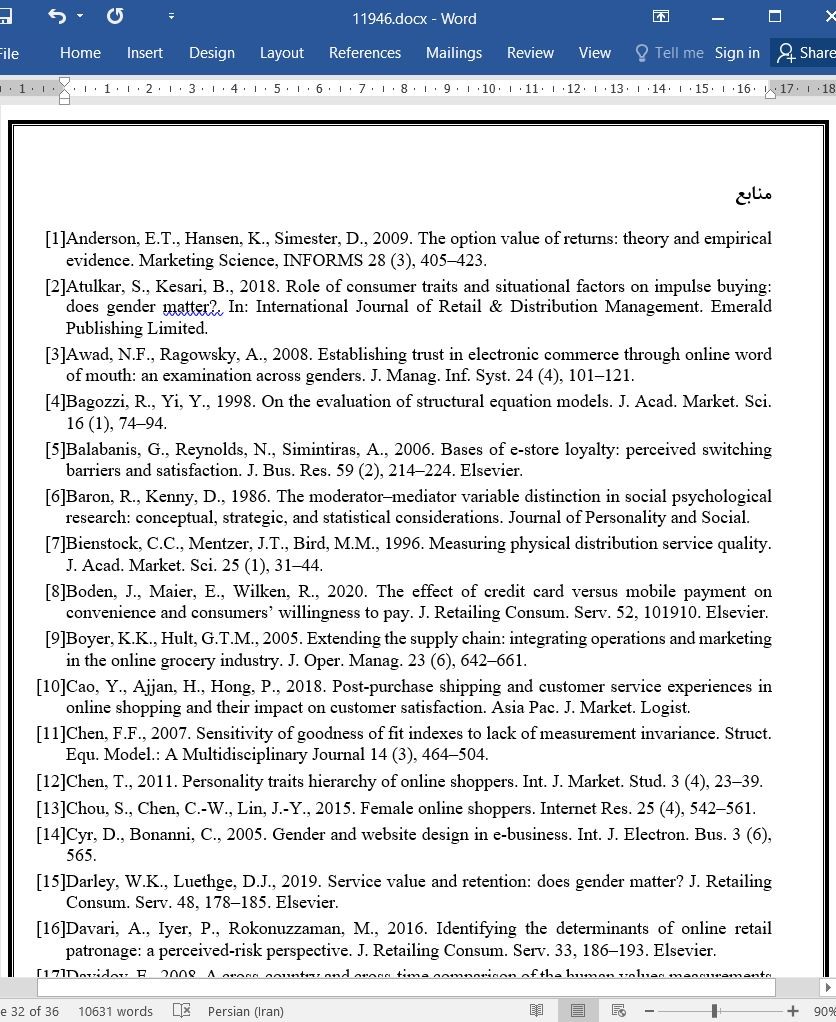
کیفیت خدمت لجستیکهای الکترونیکی و قصد خرید مجدد در تامین الکترونیکی
چکیده
این مقاله به طور تجربی به بررسی نقش واسطهای رضایت از خرید بین کیفیت خدمات لجستیک الکترونیکی (e - LSQ) و قصد خرید مجدد میپردازد. علاوه بر این ، این مقاله به بررسی نقش تعدیلکننده جنسیت ، گزینههای پرداخت و بازده یا تجربه جایگزینی در ارتباط بین کیفیت خدمات لجستیک الکترونیکی(e - LSQ) و رضایت از خرید (و قصد خرید مجدد) میپردازد. دادههای تجربی شامل ۶۴۰ خریدار آنلاین هندی با مدلسازی معادله ساختاری مبتنی بر کوواریانس تجزیه و تحلیل میشوند. یافتهها نشان داد که شرایط حمل و نقل مهمترین بعد کیفیت خدمات لجستیک الکترونیکی(e - LSQ) است و ارتباط آن با رضایت از خرید در میان گزینههای پرداخت ، جنسیت و تجربه بازگشت متفاوت میباشد. شرایط ضعیف این محموله ممکن است باعث بازگشت محموله الکترونیکی در بافت هند شده باشد. این یافتهها به مدیران تامینکننده الکترونیکی کمک خواهند کرد تا یک شبکه تدارکات قوی برای حفظ و جذب مشتریان دلسرد طراحی کنند.
1 مقدمه
تامینکنندگی الکترونیکی از طریق ارائه محصولات استانداردتر ، انواع محصولات گستردهتر ، کیفیت تحقق ، زمان تحویل ترجیحی ، دقت سفارش ، حمل و نقل رایگان ، تخفیف ، گزینه پرداخت نقدی در تحویل ، بازگشت آسان و سیاستهای مبادله ، تکاملیافته است. تدلرکات اغلب یک تمایز دهنده و مزیت رقابتی در شرکتهای خردهفروشی الکترونیکی میباشند. (Nguyen et al., 2019; Tang and Veelenturf, 2019) خرابی الکترونیک نیز باعث رشد در بخش تدارکات تامین الکترونیکی در هند شدهاست. در سال ۲۰۱۸ ، ارزش این صنعت 1/45 میلیارد دلار بود و انتظار میرفت که در سه سال آینده ۳۶ درصد رشد کند. (KPMG, 2018) با این حال فقدان زیرساخت لجستیک و خدمات الکترونیکی ضعیف چالشهایی را برای ارائهدهندگان خدمات لجستیک (LSPها)در هند ایجاد کردند. (KPMG, 2018) زیرساخت لجستیک ضعیف نه تنها زمان تحویل را افزایش میدهد بلکه به محصولات در طول ترابری آسیب میرساند. تراکنشهای لجستیک تدارکات اغلب برون سپاری میشوند که معمولا توسط تدارکات شخص ثالث انجام میشوند ( 3 PL). (Rabino-vich et al., 2007) برخی از تامینکنندگان الکترونیکی علاوه بر تدارکات شخص ثالث(3 PL) ، تدارکات داخلی خود را نیز توسعه دادهاند.
6 محدودیتها ، جهت گیریهای تحقیقاتی آینده و نتیجهگیری
اول ، این مطالعه فاقد قابلیت تعمیم میباشد چون دادهها از هند مرکزی جمعآوری شده و نمونه به سمت جوانان منحرف شدهاست. دوم ، این مطالعه محصولات را از دستههای محصول لوازم الکترونیکی مصرفکننده ، پوشاک و کتابها در نظر گرفتهاست. مطالعات آینده باید چارچوبهای مختص گروه محصول را برای به دست آوردن دیدگاههای عمیقتر در روابط توسعه دهند.
Abstract
This paper empirically examines the mediating role of shopping satisfaction between electronic logistics service quality (e-LSQ) and repurchase intention. Further, this paper investigates the moderating role of gender, payment options, and returns or replacement experience on the link between e-LSQ and shopping satisfaction (and repurchase intention). Empirical data comprising 640 Indian online shoppers are analyzed with covariance-based structural equation modeling. The findings indicated that the condition of the shipment is the most crucial e-LSQ dimension and its linkage with shopping satisfaction varies across payment options, gender, and returning experience. The poor condition of the shipment might have triggered the returns in e-tailing in the Indian context. The findings will help e-tail managers design a robust logistics network to retain and win despondent customers.
1. Introduction
E-tailing has evolved through the offering of more standardized products, wider product varieties, fulfillment quality, preferred delivery time slots, order accuracy, free shipping, discounts, cash-on-delivery payment option, easy return and exchange policies. Logistics is often a differentiator and competitive advantage in e-tailing companies (Nguyen et al., 2019; Tang and Veelenturf, 2019). Booming e-tailing has also triggered growth in the e-tail logistics sector in India. In 2018, the industry was valued at $ 1.45 billion and was expected to grow at 36 percent in the next three years (KPMG, 2018). However, lack of logistics infrastructure and the poor e-fulfillment services pose challenges for logistics service providers (LSPs) in India (KPMG, 2018). Poor logistics infrastructure not only increases the delivery time but also damages the products during shipment. Logistics transactions of e-tailing are often outsourced, usually performed by third-party logistics (3 PL) (Rabinovich et al., 2007). Some e-tailers have developed their in-house captive logistics in addition to 3 PL.
6. Limitations, future research directions, and conclusion
First, this study lacked generalizability as the data was collected from Central India, and the sample was skewed towards youth. Second, this study considered products from the product categories of consumer electronics, apparel, and books. Future studies shall develop product category-specific frameworks to gain deeper insights into relationships. Third, this study focused on the ‘pain of paying’ concept to analyze the role of payment options; however, future research can analyze how payment options can generate trust in e-tailing. Fourth, this study didn’t differentiate returns or product exchanges. Further, a longitudinal study shall be carried out to strengthen the findings.
چکیده
1 مقدمه
2 مرور مطالب و توسعه نظریه
2-1 چارچوب مفهومی
2-2 تاثیر گزینههای پرداخت
2-3 نقش جنسیت
2-4 تاثیر بازگشتها
3 روششناسی تحقیق
3-1 تکنیک نمونهبرداری
3-2 طراحی پرسشنامه
3-3 مطالعه پیش از آزمایش و پایلوت
3-4 واریانس روش مشترک
4 تحلیل آماری
4-1 ویژگیهای نمونه
4-2 ارزیابی مدل CB – SEM
4-3 ارزیابی مدل اندازهگیری
4-4 ارزیابی مدل ساختاری
4-5 تجزیه و تحلیل میانجی
4-6 تحلیل میانهروی
5 مفاهیم نظری و عملی
6 محدودیتها ، جهت گیریهای تحقیقاتی آینده و نتیجهگیری
ضمیمه A. دادههای ملزوم
منابع
Abstract
Graphical abstract
Introduction
Literature Review and theory development
Conceptual Framework
Impact of payment options
Role of gender
Impact of returns
Research methodology
Sampling technique
Questionnaire design
Pre-test and pilot study
Common method variance
Statistical analysis
Sample characteristics
CB-SEM model assessment
Measurement model assessment
Structural model assessment
Mediation analysis
Moderation analysis
Theoretical and practical implications
Limitations, future research directions, and conclusion
Appendix A. Supplementary data
References
- اصل مقاله انگلیسی با فرمت ورد (word) با قابلیت ویرایش
- ترجمه فارسی مقاله با فرمت ورد (word) با قابلیت ویرایش، بدون آرم سایت ای ترجمه
- ترجمه فارسی مقاله با فرمت pdf، بدون آرم سایت ای ترجمه



